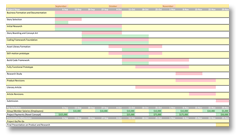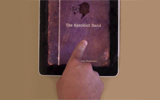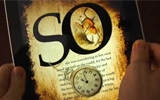Problem Statement

Current interactive electronic literature has not adequately utilized the
available technology to engage the reader and increase the perceived
entertainment value of the media presented.
Images & Video









Research
ResearchIs there a correlation between the amount of interactivity present within a piece of electronic media and its perceived entertainment value? Will adding different types of interactive elements to a piece of electronic literature increase appeal to current and potential readers?
Hypothesis
There is a positive correlation between the type of interactivity presented within a piece of electronic literature and its perceived entertainment value. Increasing the frequency and diversity of interaction will have a positive effect on the appeal of the piece of media.
Experiment
In an attempt to determine whether including interactive elements within an electronic text is a value-added activity and increases its perceived entertainment value as seen by the user, Novel Concept is creating an interactive e-book from a favorite classic and will measure any changes in user satisfaction and entertainment with increases in interactivity. For research purposes, the level of interactivity will be the only variable manipulated by the experimenters (performing the role of the independent variable), and the perceived entertainment value of the product will act as the dependent variable.
(Discover more...)
At this point, several possible extraneous variables that could possibly affect
the interaction between independent and dependent variables have been evaluated
as participants' preexisting feelings towards electronic texts, reading, the
Sherlock Holmes collection, or technologies present in the experiment setting.
In an attempt to understand any influence of these variables on the dependent
variable, participants will be surveyed prior to the start of the experiment
for demographic information as well as information specifically relating to the
above points. Further, to limit the effect of possible extraneous variables
such as differences in environment or product differences other than those
formed by the independent variable, all participants will receive the same
treatment in regards to the allotment of time to read the material, testing
environments will remain constant, and product look and feel will be kept the
same.
Relative stability of the dependent variable is also hoped to be achieved by delivering the same instructions to all participants and to avoid any ambiguous or leading statements that could introduce either the Hawthorne or experimenter effects into the interaction between variables. Survey questions will be screened in advance so that they are understandable and unbiased.
The experiment itself will be conducted in accordance with a within-subjects design. Participants randomly selected and assigned to two groups, with both groups eventually receiving both treatments. Group A will begin with the control condition and will receive a non-interactive (but in all other regards, exactly the same) version of the electronic text at the same time that Group B will receive the interactive version of the text. Both will be given a short survey about their experience then receive the other treatment and subsequent survey. Results will then be compared against the null hypothesis that there is no relationship between interactivity and entertainment and that adding interactivity will not also increase user satisfaction with the product.
Relative stability of the dependent variable is also hoped to be achieved by delivering the same instructions to all participants and to avoid any ambiguous or leading statements that could introduce either the Hawthorne or experimenter effects into the interaction between variables. Survey questions will be screened in advance so that they are understandable and unbiased.
The experiment itself will be conducted in accordance with a within-subjects design. Participants randomly selected and assigned to two groups, with both groups eventually receiving both treatments. Group A will begin with the control condition and will receive a non-interactive (but in all other regards, exactly the same) version of the electronic text at the same time that Group B will receive the interactive version of the text. Both will be given a short survey about their experience then receive the other treatment and subsequent survey. Results will then be compared against the null hypothesis that there is no relationship between interactivity and entertainment and that adding interactivity will not also increase user satisfaction with the product.
Elevator Statement
After its release in 2010, the iPad took only 28 days to reach the 1 million mark in sales—about half as long as did the first generation iPhone. The popularity of iPads has sparked a technical revolution of sorts, as competitors fight to release a comparable product and apps flood the market. Now the consumer can physically interact with items on the screen: touch an object, and it will move.
(Discover more...)
This new innovation is especially relevant for electronic literature. The iPad
already lends users the ability to turn pages much like they would a real book
(the user can drag their finger across the screen and the corner of the page
will follow the same path), but what would happen if we blended the rest of its
capabilities with that same piece of literature?
Alice for the iPad was the first eBook to explore this option. Released April, 2010, this curious app takes the Lewis Carroll original and adds physics to some of the original illustrations, bringing Alice's peculiar adventures to life. Though other interactive media has since been released, Alice was the first of its kind.
Naturally, we were curious. After reading blog entry after blog entry about how awesome Alice was, we decided to download the app for ourselves and try it out. We have to admit, we were a little disappointed. However, this disappointment soon led to excitement, because of the many opportunities we saw in Alice's failings. First of all, we must admit that the app was impressive. It was fun to play with, and a creative idea. However, we noticed something: we didn't bother reading the text. We would simply flip through the pages until we found one we could interact with. This led us to another discovery: the type of interaction was the same across the text. Every item could be moved by tilting the iPad or swiping at it with your finger. There was also an abundance of floating objects throughout the piece that would float around over the text.
We propose that by introducing a different type of interactivity to a piece of literature, we can better mesh classic literature and its modern counterpart. This is based on several research findings that visual elements properly related to the available text will increase the reader's involvement with the material. The interactive elements in this new eBook will relate the reader to specific actions within the text by having them complete several actions performed by the characters, as well as aiding in the visualization of scenes and characters, therefore increasing his interest in the story and its perceived entertainment value.
Alice for the iPad was the first eBook to explore this option. Released April, 2010, this curious app takes the Lewis Carroll original and adds physics to some of the original illustrations, bringing Alice's peculiar adventures to life. Though other interactive media has since been released, Alice was the first of its kind.
Naturally, we were curious. After reading blog entry after blog entry about how awesome Alice was, we decided to download the app for ourselves and try it out. We have to admit, we were a little disappointed. However, this disappointment soon led to excitement, because of the many opportunities we saw in Alice's failings. First of all, we must admit that the app was impressive. It was fun to play with, and a creative idea. However, we noticed something: we didn't bother reading the text. We would simply flip through the pages until we found one we could interact with. This led us to another discovery: the type of interaction was the same across the text. Every item could be moved by tilting the iPad or swiping at it with your finger. There was also an abundance of floating objects throughout the piece that would float around over the text.
We propose that by introducing a different type of interactivity to a piece of literature, we can better mesh classic literature and its modern counterpart. This is based on several research findings that visual elements properly related to the available text will increase the reader's involvement with the material. The interactive elements in this new eBook will relate the reader to specific actions within the text by having them complete several actions performed by the characters, as well as aiding in the visualization of scenes and characters, therefore increasing his interest in the story and its perceived entertainment value.

